When you head to the range, you need appropriate protective safety gear, which basically means eye and hearing protection — informally known as “eyes and ears.” But saying you need eye and ear protection is like saying you need shoes, and there’s a big difference between steel-toed hiking boots and strapless pumps with five-inch heels. Let’s look at eye protection first...
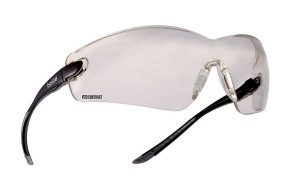 Simple question with an easy answer — why do you wear eye protection at the range? To keep things out of your eyes. Since we’re talking about shooting, that means eyeglasses that wrap around or protect your eyes from the side as well, as ricochets happen.
Simple question with an easy answer — why do you wear eye protection at the range? To keep things out of your eyes. Since we’re talking about shooting, that means eyeglasses that wrap around or protect your eyes from the side as well, as ricochets happen.
Anyone who has ever worked in a factory has worn safety glasses, but there is a difference between simple safety glasses and ballistic shooting glasses. Safety glasses are designed to stop debris from getting into your eyes. Ballistic glasses have met the military requirement for ballistic resistance testing and the ANSI requirement for high velocity impacts. Many companies such as Champion make both types of glasses, but don’t simply search for the term “ballistic.” Bollé sells 77 different types of “safety glasses” in addition to “tactical spectacles,” but many of their glasses meet and exceed U.S. military and NATO specifications for ballistic resistance, even though they don’t have the word ‘ballistic’ in the name.
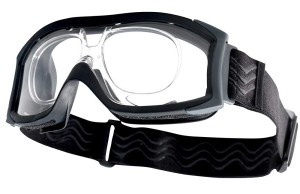 It is the rare pair of simple safety glasses which won’t stop anything thrown their way at a shooting range, but some shooters love the added security of glasses that they know have been tested to stop bird shot and bullet jacket fragments.
It is the rare pair of simple safety glasses which won’t stop anything thrown their way at a shooting range, but some shooters love the added security of glasses that they know have been tested to stop bird shot and bullet jacket fragments.
Protection isn’t everything when it comes to safety glasses, however. Everyone looks cool in sunglasses, but if the majority of your shooting is done at an indoor range, they’re the last kind of lenses you want. If you do a lot of shooting in bright sunlight, dark lenses might be for you. Yellow lenses are almost old-fashioned now, but they are popular with a lot of experienced shooters, because they tend to make targets pop against the backdrop. The problem with yellow lenses is they make everything brighter, so on a bright sunny day, they may be too bright for some people. Increasingly popular are orange or amber lenses which seem to bring out detail while still being usable even in bright desert conditions.
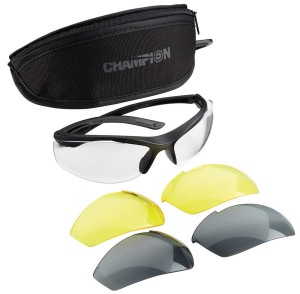 Many companies offer glasses with interchangeable lenses and offer clear, amber/yellow, and smoke lenses, so the shooter has every type of lens they might possibly need all with one purchase. Champion sells a set of ballistic shooting glasses with interchangeable lenses for only $24.95, which is a remarkable value. If you wear prescription lenses, you have several options between buying a set of safety glasses which fit over your prescription set (a relatively cheap solution) or buying a high-end set of safety glasses which accept prescription lenses.
Many companies offer glasses with interchangeable lenses and offer clear, amber/yellow, and smoke lenses, so the shooter has every type of lens they might possibly need all with one purchase. Champion sells a set of ballistic shooting glasses with interchangeable lenses for only $24.95, which is a remarkable value. If you wear prescription lenses, you have several options between buying a set of safety glasses which fit over your prescription set (a relatively cheap solution) or buying a high-end set of safety glasses which accept prescription lenses.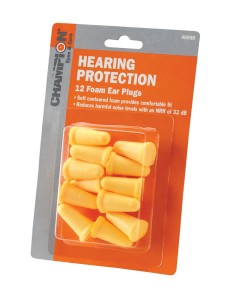
Hearing protection (“earpro”) is another must have in your list of safety gear, and when it comes to reducing abuse to your eardrums, you have two options — plugs or muffs. Both have advantages and disadvantages, and all plugs and muffs have specific noise reduction ratings (NRRs).
Earmuffs just by their very nature do a better job of blocking sound. They completely enclose the ear. Plain or passive muffs are a great choice when shooting inside, or outdoors when the weather is cool or cold.
When I got heavily into competition shooting, however, I found that having plastic-coated foam pads around your ears while shooting in 90-degree heat sucks. The sweat would just drip from my head. In addition, muffs were bulkier than plugs, and became just one more piece of gear to try to fit in my range bag — never an issue with earplugs, which are tiny in comparison.
Women tend to dislike earmuffs more than men because they mess up their hair. And then there is the issue of sympathetic fit with your eye protection.
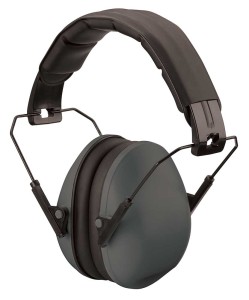 The temples of your protective eye glasses go right over your ears, right where earmuffs press tight against your head. If the eyeglass temples are flat you won’t have a problem, but if they come into your head at an angle or have even a minor S-curve, you may find they are very uncomfortable to wear with ear muffs. If you have a set of glasses and/or muffs you really like and are looking for a new pair of the other, try them on together at the store to make sure the combo won’t cause you pain.
The temples of your protective eye glasses go right over your ears, right where earmuffs press tight against your head. If the eyeglass temples are flat you won’t have a problem, but if they come into your head at an angle or have even a minor S-curve, you may find they are very uncomfortable to wear with ear muffs. If you have a set of glasses and/or muffs you really like and are looking for a new pair of the other, try them on together at the store to make sure the combo won’t cause you pain.
Muffs have seen a resurgence in popularity in the last decade or so specifically because of technology. Electronic hearing protectors are very common now. Just about everyone I see at matches these days wearing muffs is wearing electronic muffs. Electronic earmuffs have microphones that pick up and, in most cases, can amplify the sound around you. You can converse with people in a normal conversational tone, and yet the sound cuts off when loud noises (like gunshots) erupt. It wasn’t until a few years ago that I actually got a pair of electronic muffs, and I was really impressed at the technology. They work.
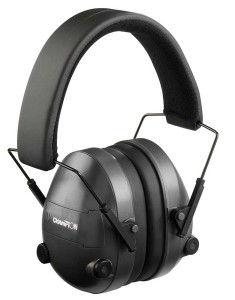 At a recent media event, I found myself standing in a shooting bay filled with gunwriters and manufacturer’s reps — what would be called industry professionals. Weather was about 60 degrees; not hot, but not cold. I did a count — of the 24 people there, 14 were using earplugs, and 10 were wearing ear muffs. Of the muffs, 9 out of the 10 were electronic, which should tell you just how popular and effective modern muffs are.
At a recent media event, I found myself standing in a shooting bay filled with gunwriters and manufacturer’s reps — what would be called industry professionals. Weather was about 60 degrees; not hot, but not cold. I did a count — of the 24 people there, 14 were using earplugs, and 10 were wearing ear muffs. Of the muffs, 9 out of the 10 were electronic, which should tell you just how popular and effective modern muffs are.
For actual comfort and noise reduction, foam earplugs are my actual favorite type of earpro. I can wear them all day and not be bothered by the feel of them in my ears, and they reduce decibels nearly as much as muffs. And they are inexpensive.
But foam plugs are not perfect. They can be frustrating to get in your ears — you have to roll them up between your fingertips and then stuff them into your ear canal before they expand again. If you’re shooting with your kids, you generally can’t get the foam plugs small enough to fit into their ears. And then they have a limited life span. The foam can only be squeezed so many times before it loses its consistency and you have to throw them away. But again, they’re inexpensive. I always keep a mixed Ziploc bag of earplugs in my range bag.
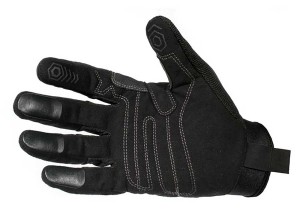 Many companies like Champion are smart — they sell every type of earpro there is, from plugs to muffs to electronic muffs. No matter what you want, they’ve got it. One-stop shopping is the very definition of convenience.
Many companies like Champion are smart — they sell every type of earpro there is, from plugs to muffs to electronic muffs. No matter what you want, they’ve got it. One-stop shopping is the very definition of convenience.
“Eyes and ears” may not be the only kind of safety gear you need at the range. I’m just now recovering from a nasty injury to my shooting hand, which could have been avoided if I’d simply been wearing gloves.
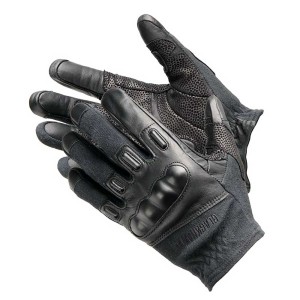 Blackhawk makes just about every type of glove you might need, whether you’re looking for shooting gloves or tactical gloves. In fact, they are considered the first and last word in tactical gloves.
Blackhawk makes just about every type of glove you might need, whether you’re looking for shooting gloves or tactical gloves. In fact, they are considered the first and last word in tactical gloves.
What’s the difference between shooting and tactical gloves? Shooting gloves cover and protect your hands, and often offer a little padding and reinforcement. Tactical gloves tend to offer more protection. Some are made of Kevlar and are cut-resistant, others have Nomex for fire resistance. A few even have reinforced knuckles, in case you have to punch a terrorist in the face in the middle of a gunfight. For most of us, all we’ll need are gloves that protect our hands and are maybe lined with fleece for cold weather protection.
 What about the rest of your body? The first time I ever fired a shotgun from the prone position, it was on gravel at one of the first major tactical shooting matches I ever attended. I walked away with bloody elbows. Most people shoot while standing on their feet, but if you do any competition shooting or take any self-defense classes, you may find yourself shooting from your knees or the ground in any number of awkward positions. If you do, trust me, you’ll appreciate a good set of knee and/or elbow pads. Blackhawk sells those as well, and they’re less expensive than you might think.
What about the rest of your body? The first time I ever fired a shotgun from the prone position, it was on gravel at one of the first major tactical shooting matches I ever attended. I walked away with bloody elbows. Most people shoot while standing on their feet, but if you do any competition shooting or take any self-defense classes, you may find yourself shooting from your knees or the ground in any number of awkward positions. If you do, trust me, you’ll appreciate a good set of knee and/or elbow pads. Blackhawk sells those as well, and they’re less expensive than you might think.
On the line at the shooting range is not the time to be wondering what safety gear you might need. With a little forethought, you can make your shooting experience safer and more enjoyable.
No comments:
Post a Comment